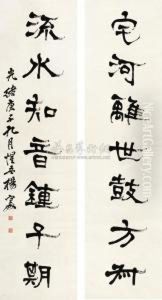Yang Shoujing Paintings
Yang Shoujing was a prominent Chinese calligrapher, painter, epigrapher, and scholar of the late Qing Dynasty. Born on September 13, 1839, in Yuyao, Zhejiang Province, he displayed a prodigious talent for the arts and classical studies from an early age. Throughout his life, Yang was deeply involved in the study of steles and stone inscriptions, which greatly influenced his calligraphic style.
Yang's scholarly pursuits were wide-ranging, encompassing history, geography, and epigraphy. He is particularly renowned for his work in the field of epigraphy, the study of inscriptions. His efforts in collecting and studying ancient inscriptions significantly contributed to the preservation of Chinese cultural heritage. Yang's dedication to epigraphy also informed his calligraphy, as he often drew inspiration from the ancient styles found in his studies.
In addition to his scholarly contributions, Yang Shoujing was an accomplished artist. His paintings and calligraphic works are characterized by their classical elegance and profound sense of historical continuity. Although he did not hold any official government position due to the tumultuous period during the late Qing Dynasty, which saw the Taiping Rebellion and other upheavals, Yang remained a respected figure in the cultural and academic circles of his time.
Yang's legacy is preserved through his numerous written works and his contributions to the preservation of Chinese historical texts and artifacts. His dedication to the study of ancient Chinese culture has made him a respected figure in the field of Chinese art history, with many of his works and collections held in high esteem by later generations of scholars and collectors.
Yang Shoujing passed away on April 18, 1915. Despite the political and social changes that have occurred since his death, his work continues to be influential, serving as a bridge between the traditional scholarship of the Qing Dynasty and modern Chinese historiography and art.
